
back to Elongated Skulls from Ancient Races on Earth

|
Although the information below is based on examination of the extreme long skulls from the Paracas people in Peru above left), other types of long skulls are also completely natural and imply a different kind of human species. The picture in the middle is typical for Britain and Malta and shows a horizontal long skull, while the picture on the right is from Russia and shows a natural slanted upwards long skull. First I have to say that intentional or so-called artificial cranial deformation is actually a rarity. There are some pictures circulating on the web of Africans who bind the skull of their baby with cloth. This produces a skull that is cylindrical in shape, a little bit longer, but the skull width has become much narrower. The skulls we are talking about in this article do not show a narrowing of the skull, they are long and have their full width. They do not have any signs of being compressed. The so-called cradle-boarding with planks is a fantasy, because it would produce a skull that is actually less long, as it would have been flattened length wise. Elongated skulls, that is, with a longer than usual skull, have been found around the world, and are displayed in various museums. They are from human beings but with a different form and size of skull. Scientists who are knowledgeable about cranial features, and who have actually have studied the skulls, came to the conclusion that these elongated skulls were not artificially elongated. They were natural, and were not intentionally deformed. Renewed study of the elongated skulls in the last decade has shown that, at least for those skulls examined, there were no signs of artificial deformation. |
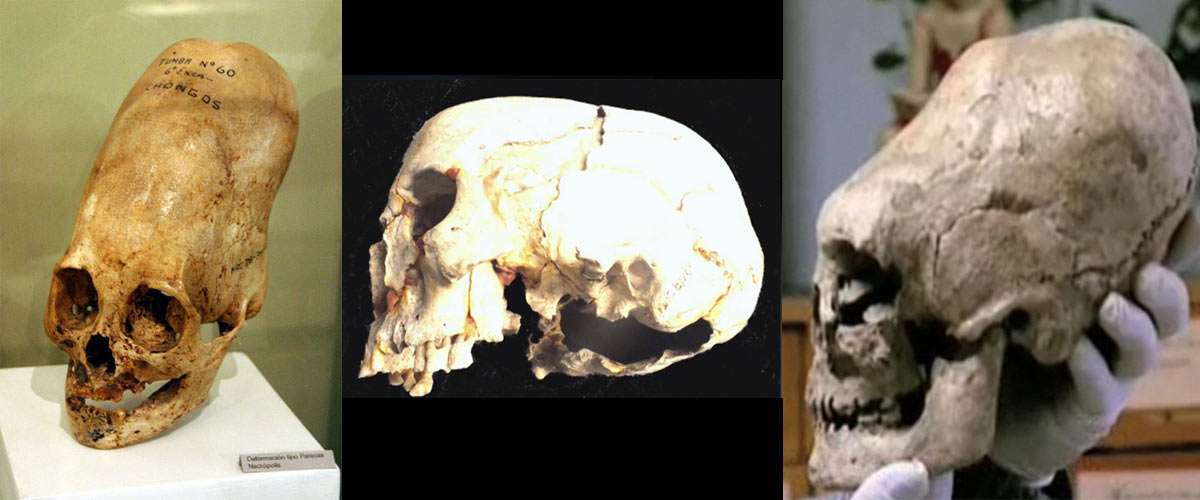
|
Here are three examples of scientists who carefully examined some elongated skulls and who came to the conclusion that these long skulls were natural, and did not show any signs of deformation, followed by examples of baby mummies with natural, inherited long skulls. Text between square brackets [] and bold emphasis are mine. |
Examination by Scientists:
|
But, in our opinion, those physiologists are undoubtedly in error, who suppose that the different phrenological aspects offered by the Peruvian race were exclusively artificial. This hypothesis rests on insufficient grounds; its authors could have made their observations solely on the crania of adult individuals, as it is only a few years since two mummies of children were carried to England, which, according to the very exact description of Dr. Bellamy, belonged to the tribe of Aymaraes. The two crana (both of children scarce a year old) had, in all respects, the same form as those of adults. We ourselves have observed the same fact in many mummies of children of tender age, who, although they had cloths about them, were yet without any vestige or appearance of pressure of the cranium. More still : the same formation of the head presents itself in children yet unborn; and of this truth we have had convincing proof in the sight of a foetus, enclosed in the womb of a mummy of a pregnant woman, which we found in a cave of Huichay, two leagues from Tarma, and which is, at this moment, in our collection. Professor D'Outrepont, of celebrity in the department of obstetrics, has assured us that the foetus is one of seven months' age. It belongs, according to a very clearly defined formation of the cranium, to the tribe of the Huancas. We present the reader with a drawing of this conclusive and interesting proof in opposition to the advocates of mechanical action as the sole and exclusive cause of the phrenological form of the Peruvian race. The same proof is to be found in another mummy which exists in the museum of Lima, under the direction of Don M. E. de Eivero. It is not possible to explain how, by means of pressure with fillets or bandages, the occipital bone can be transformed to a plane almost horizontal, without producing, at the same time, a considerable declination of the sinciput; which last is entirely wanting in the Aymaraes, and which we yet find in the Huancas, whose occiputs, notwithstanding, show no sign of pressure, not being, by any means, able to preserve their regular inclination as the points of resistance to a frontal pressure. The considerable extension in length of the frontal bone of the parietals, and of the occipital in the last two races, might sometimes lead one to suspect pressure on the sides; but to this opinion is opposed the inclination of the frontal and occipital bone; but the most effectual proof against the use of mechanical means will, after all, be found in the actual existence of the three races in distinct though limited localities, in which there cannot be found any traces of envelopment or pressure of the head in the newly-born. |
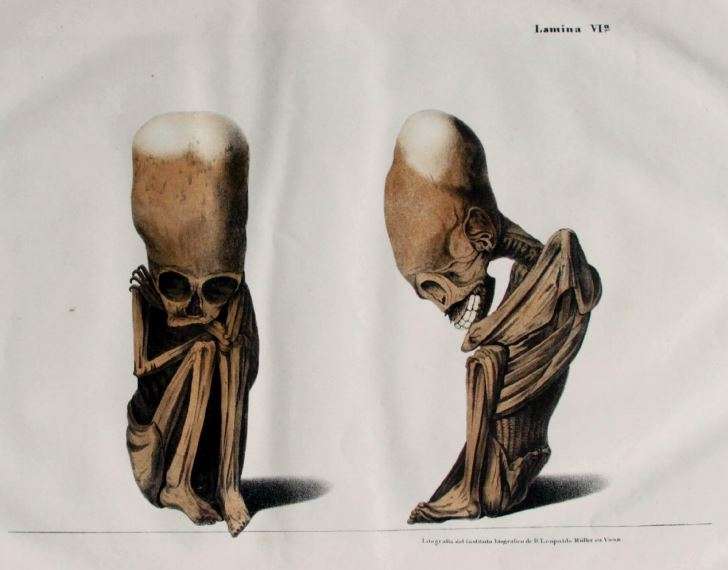
|
A brief Account of Two Peruvian Mummies in the Museum of the Devon and Cornwall Natural History Society, by By P. F. Bellamy, Surgeon, of Plymouth (in THE ANNALS AND MAGAZINE OF NATURAL HISTORY 5 INCLUDING ZOOLOGY, BOTANY, and GEOLOGY, Volume 10, 1842, London), page 96-100: By a coincidence, the mummies under our immediate notice are the remains of children, one of which was not more than a few months old, and the other could not be much more than one year; and judging from their relative size and figure, male and female. PI. IV. figs. 1 and 3 ... [the drawing is shown below] Corresponding with this configuration, all the large bones of the skull are considerably elongated... It will be manifest from the general contour of these skulls that they are allied to those in the Museum of the College of Surgeons in London, denominated Titicacans. Those adult skulls are very generally considered to be distorted by the effects of pressure; but in opposition to this opinion Dr. Graves has stated, that "a careful examination of them has convinced him that their peculiar shape cannot be owing to artificial pressure;" and to corroborate this view, we may remark that the peculiarities are as great in the child as in the adult, and indeed more in the younger than in the elder of the two specimens now produced: and the position is considerably strengthened by the great relative length of the large bones of the cranium; by the direction of the plane of the occipital bone, which is not forced upwards, but occupies a place in the under part of the skull; by the further absence of marks of pressure, there being no elevation of the vertex nor projection of either side; and by the fact of there being no instrument nor mechanical contrivance suited to produce such an alteration of form (as these skulls present) found in connexion with them. ... Bellamy adds a note in which he explains why the skulls could not have been compressed with bandages. I have added, in square brackets, some clarification of the scientific terms he uses. Below I have added an image with the terms denoting the different regions of the skull. Note. — After the reading of this paper, Prof. Owen stated that he entertained an opinion that their peculiar form was given to them by pressure, such as might be applied by a bandage passed round the head; and he suggested that a short fillet (about 16 inches long) found with the younger of the two mummies might have been employed for this purpose. This bandage, however, I consider was used to secure the lower extremities to the trunk, and on consideration I am disposed to maintain the same opinion as I have stated above : 1st, because this fillet is but 1 1/2 inch wide, whereas the flattened portion of the skull is more than 3 inches, extending over the os frontis [frontal bone] from immediately above the superciliary ridges [brow ridges above the eye sockets] to an inch beyond the coronal suture, so as to involve the anterior portion of the parietal bones [the two skull plates at the top of the skull]; 2nd, the line of depression in these skulls has a direction over the middle of the os occipitis [or occipial bone which is the lower back part of the skull], and then over the anterior third of the parietal bones, first where the angle dips down between the frontal temporal bones {which are at the side and base of the skull}, and then immediately behind the coronal suture, and not at all over the os frontis; 3rd, because, if pressure had been used in this direction, it would have contracted the great fontanelle [the frontal fontanelle, or opening between the skull plates], of which there is no mark whatever; indeed in the elder of the two, in which the depressed line is most visible, the fontanelle is most open; and lastly, if a circular bandage had been applied, it would have given a circular form to that portion at least compressed by it; whereas however a transverse section, taken by measurement, shows that the skulls have a compressed pyriform [pear shaped] figure, the larger extremity representing the flattened and upper surface, and the smaller corresponding with the contracted aspect of the occipital bone. |
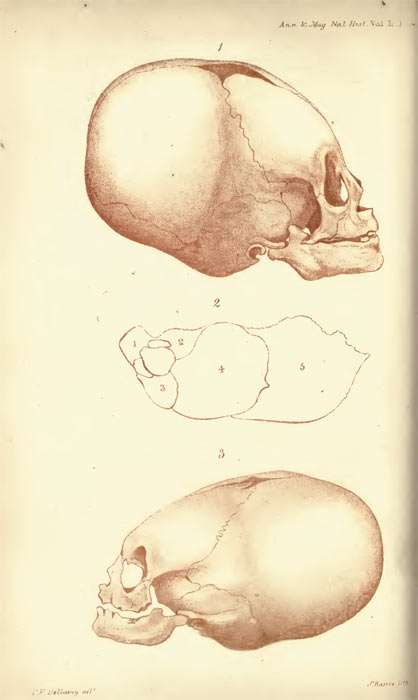 PI. IV. figs. 1 and 3, from the book |
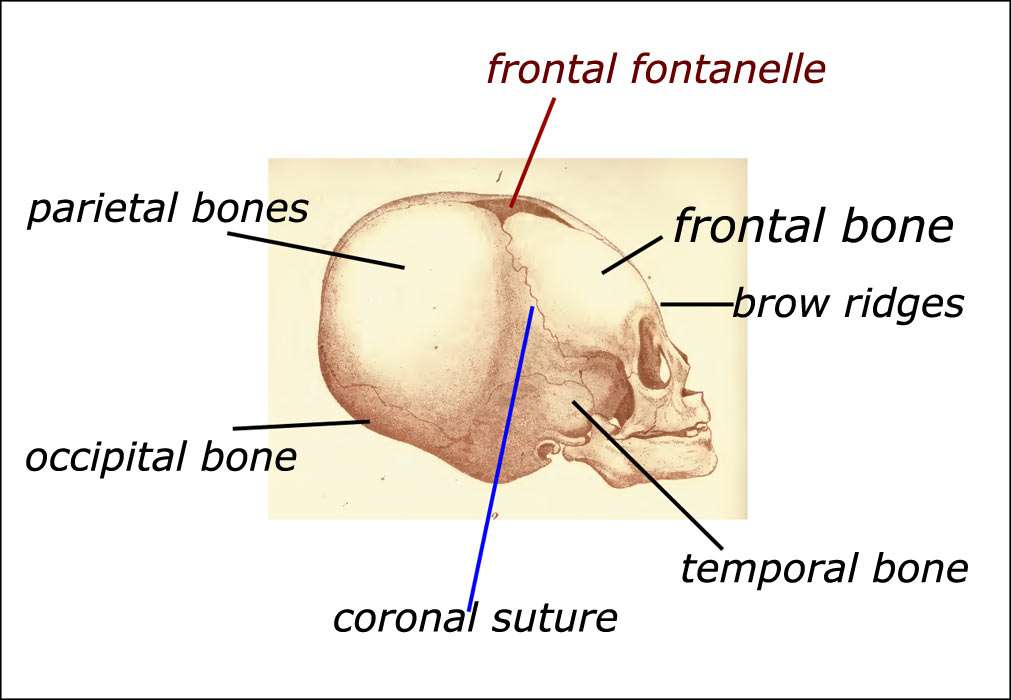 |
|
Here Graves himself writes in Remarkable skulls found in Peru. The Dublin Journal of Medical and Chemical Science. No. 15, 1834, page 477 in regards to some adult skulls which he saw in the Museum of Comparative Anatomy in Paris, and which were brought there from Peru by J. R. Pentland: "A careful examination of these skulls has convinced me that their peculiar shape cannot be owing to artificial pressure. The great elongation of the face and the direction of the plane of the occipital bone are not to be reconciled with this opinion, and therefore we must conclude that the peculiarity of shape depends on a natural conformation. If this view of the subject be correct, it follows that these skulls belonged to a race of mankind now extinct, and which differed from any now existing. " |
Babies with an Elongated Head:
|
4480 B.C., an 8 to 10 month old baby died in Peru. An x-ray scan revealed it died from a malformed heart. Originally the mummy was owned by Völkerkundliches Museum (Ethnological Museum) of the city of Witzenhausen. After an affection of mold was recognized on the mummy, it was donated to Lippisches Landesmuseum Detmold, where it was professionally conserved. It has become known at the Detmold child. |
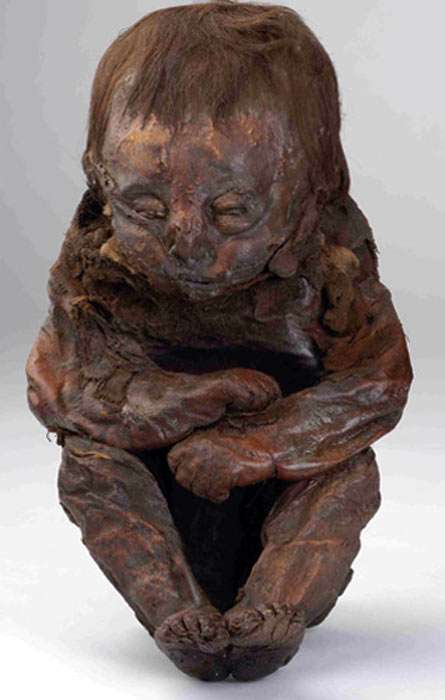 the Detmold Child front view |
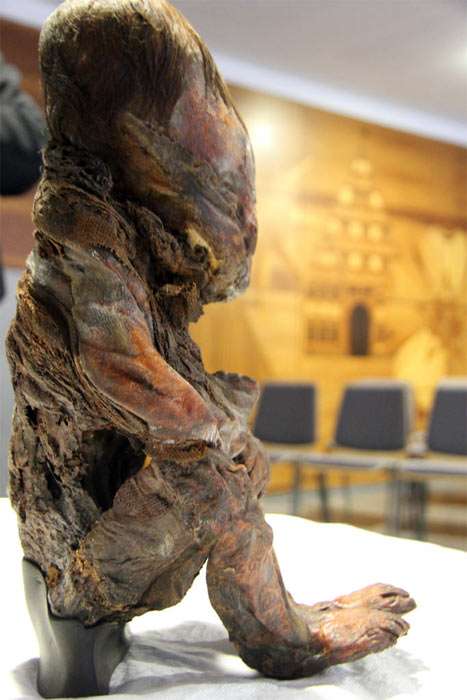 the Detmold Child side view |
 the Detmold Child x-ray scan |
 the Detmold Child close-up of the head |
|
In 2016, Brian Foerster, from Hidden Inca Tours, took a trip to the Patapatani museum in Peru, where two skeletons were stored that archaeologists had excavated in the region. One was of a young woman with elongated skull, and her seven to nine months fetus also with elongated head. The mother likely died during childbirth. Pictures from his website: |
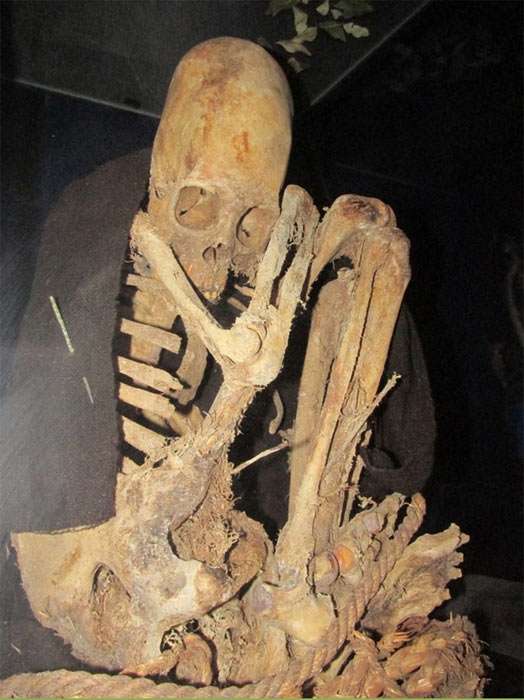 skeleton with elongated head in Patapatani museum |
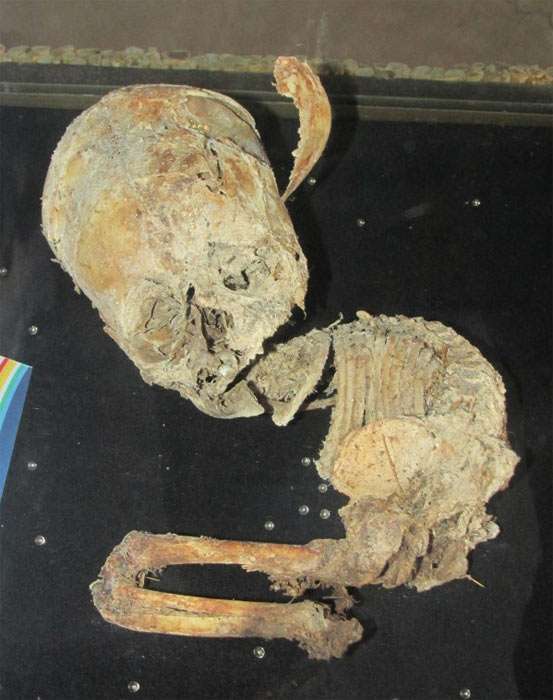 the fetus which already has an elongated skull |
|
Brian Foerster also (2017) brought to light the mummy of a three month old baby (owned by a private individual in Peru) with the typical long skull which is at least twice the size of a normal human baby skull of that age. Here there was no time for any cranial deformation by binding or other means to take place. The baby was born with this long skull. Picture is from his video: |
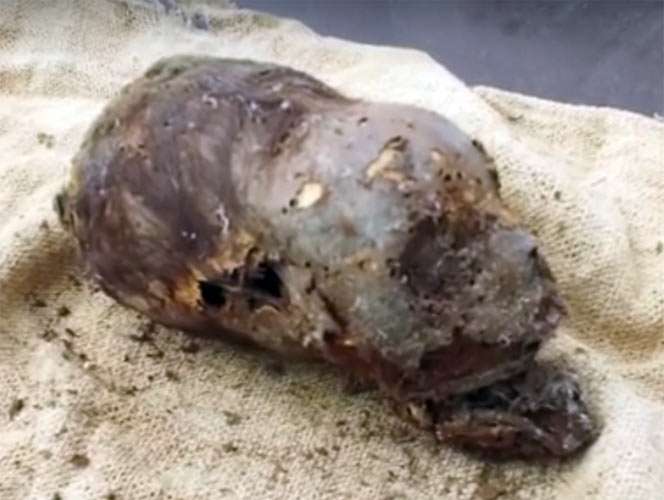
|
|